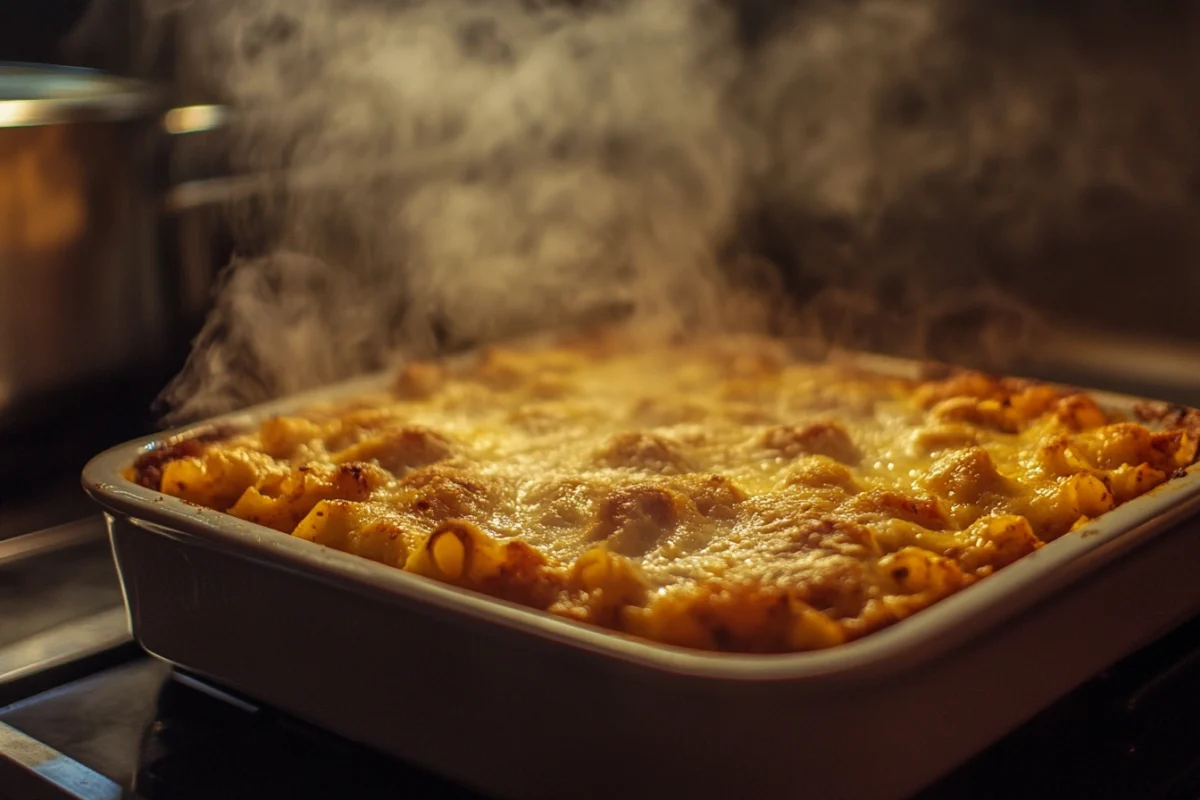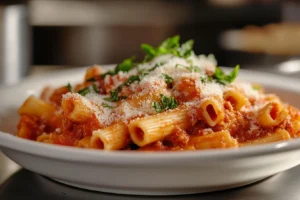Should baked ziti be covered when baking? This article explores if covering this delicious pasta dish enhances or hinders its perfection. Discover the best techniques for a wonderfully baked ziti.
Should Baked Ziti Be Covered While Baking?
Whether to cover baked ziti during baking is a common question. The answer, however, isn’t always straightforward, as it depends on the desired outcome. This article delves into the reasons and benefits of covering or not covering this classic Italian-American dish. Additionally, we’ll discuss the science behind these techniques, so you can make an informed decision.
Learn how to make a Baked Ziti Recipe Without Meat for a vegetarian-friendly version of this classic dish.
Why Cover Baked Ziti?
Covering baked ziti, for example, helps retain moisture. This prevents the pasta from drying out during baking. Additionally, it allows the dish to cook more evenly. The steam that forms under the cover helps to meld the flavors together effectively. Furthermore, a covered bake often results in a softer, more tender texture. Therefore, if you want a moist and creamy baked ziti, covering it is usually best. The moist environment also aids in the thorough cooking of all the elements.
Benefits of Covering
First, moisture retention is key to a great baked ziti. Covering the dish traps steam inside, keeping the pasta soft. Second, even cooking is another benefit. Heat is distributed uniformly when covered, avoiding hot spots. Third, flavor melding happens more efficiently. The enclosed space helps the flavors of cheese, sauce, and pasta blend beautifully. Consequently, the taste is often richer and more harmonious. Moreover, the steam helps the cheese melt evenly across the surface. In addition, the steam softens the pasta to create an enjoyable texture.
Why Not Cover Baked Ziti?
On the other hand, there are situations where not covering baked ziti is preferable. For instance, if you want a slightly crispy top, leaving the dish uncovered for a portion of the baking time is ideal. This allows the cheese to brown and become bubbly. Also, some people enjoy the slightly drier, more textured edges that come from uncovered baking. Hence, the decision to cover or not is a matter of preference. Furthermore, the direct heat allows for some evaporation, concentrating the flavors.
Benefits of Uncovered Baking
First, a crisp, golden top adds texture. The direct heat caramelizes the cheese. Second, some prefer the slightly drier edges. These edges give a nice contrast to the soft center. Third, it can be visually appealing. The browned cheese can make the dish look more attractive. Therefore, uncovered baking has its advantages depending on the desired texture. Additionally, this method creates a more varied texture profile. The interplay of soft and crisp makes each bite enjoyable.
The Perfect Baked Ziti: Covered or Uncovered
Ultimately, the key to perfect baked ziti involves understanding both techniques. It is often beneficial to use a combination. Usually, you would cover the dish for most of the baking time. Afterward, you remove the cover for the last few minutes. This method helps achieve both a moist interior and a nicely browned top. This method ensures you get the best of both worlds. Additionally, the two-stage process caters to both moisture and texture preferences.
Balancing Moisture and Crispness
Balancing the two is crucial. Covering baked ziti initially ensures it cooks evenly and stays moist. The steam helps soften the pasta and blend flavors. Removing the cover later allows the cheese to melt and bubble properly. This two-step method is how many achieve that ideal baked ziti. Therefore, timing is critical to the success of your dish. Consequently, mastering this balance can elevate your baking results significantly.
Baked Ziti Baking Techniques
First, always start with a good base of sauce and cheese. Second, pre-cook your pasta slightly to avoid mushiness. Third, cover your dish for the majority of the baking time. Fourth, uncover for the final 10 to 15 minutes. Fifth, watch the cheese carefully to prevent burning. This will give you the best balance of moisture and texture. Finally, let the baked ziti rest for a few minutes before serving. Following these steps will ensure a beautifully textured dish. In addition, these techniques are tried and true for success.
Different Methods for Baking Baked Ziti
There are numerous ways to bake baked ziti, and each one can influence the final result. Some people prefer using aluminum foil. Others opt for a lid that fits their baking dish. The type of cover can affect how the heat circulates. Moreover, how well it retains steam. Consequently, understanding the differences can help you make better choices. The choice depends largely on available equipment and personal convenience.
Aluminum Foil vs. Lid
Aluminum foil is a simple option, for example. It is easily available and provides a good seal. However, be careful that it does not stick to the cheese. A lid, however, often gives a more even steam distribution. This is because it is often fitted to the dish. Both methods can work effectively, so choose what best fits your needs. Therefore, think about the fit and convenience when selecting. Furthermore, consider the type of baking dish you use as this can also influence the effectiveness of the cover.
Adjusting Baking Time
Baking time for baked ziti can also vary. Depending on the recipe and the oven. Usually, it takes around 30 to 45 minutes at 375°F (190°C). However, larger batches may require more time. Always check the internal temperature to ensure it is thoroughly heated. Subsequently, adjust your baking time as needed to avoid under or overcooking. Use a thermometer to make sure the center reaches a safe temperature. In addition, always take a look at the overall color of the cheese to make sure it is ready.
Oven Temperature
Oven temperature is another important factor. Most baked ziti recipes suggest 375°F (190°C). This temperature allows the pasta to bake properly. Too high, and the top will burn before the inside cooks. Too low, and the dish will take too long to heat through. Consequently, maintaining a consistent temperature is essential for the best results. Furthermore, invest in an oven thermometer to make sure it is cooking at the correct temperature. This step will ensure your food is properly cooked.
Ingredients Affecting the Baking Process
The ingredients you use also play a role in how your baked ziti will bake. For instance, the type of sauce and cheese can affect the moisture content. High moisture ingredients might mean you need to cover it longer. Conversely, drier ingredients may benefit from a shorter cooking time. Consequently, consider how each component influences the outcome. In addition, adjusting your method based on your ingredient choices will help achieve perfect results.
Sauce and Moisture Levels
A very watery sauce, for example, will release more steam. Therefore, you might not need to cover it as long. On the other hand, a thick sauce might need more steam to fully meld with the pasta. Therefore, adjust your baking based on your sauce consistency. Always make sure the pasta is fully cooked without being too soft. Additionally, if your sauce is too thick, you might need to add a little bit of water. Consequently, this will help ensure moisture during baking.
Cheese and Browning
The type of cheese affects how it browns during baking. Mozzarella cheese, for example, melts easily and browns well. Ricotta cheese adds a creamy texture but doesn’t brown as much. Adding a bit of parmesan can create a beautiful golden crust. Hence, choose your cheese blend carefully for the desired look and taste. Furthermore, a mixture of cheeses will give you a complex flavor and a good browned appearance. Also, consider using low moisture mozzarella to avoid a watery result.
Troubleshooting Common Baked Ziti Issues
Sometimes, problems can arise with your baked ziti. However, many of these issues can be easily fixed. Common problems include a dry or a soggy dish. Both can usually be resolved with a bit of adjustment to your baking method. Additionally, understanding these fixes can improve your skills at making the best possible baked ziti. Therefore, learning how to adjust your techniques will make you a master of this dish.
Preventing Dryness
First, dryness is often caused by not enough moisture. Therefore, make sure to use enough sauce. Second, try covering the dish longer. Third, consider adding a bit of liquid, such as pasta water, to the sauce. Hence, keeping enough moisture in the dish is vital for a great result. Also, use a good quality sauce that isn’t too thin. In addition, adding a bit of broth to your sauce can add moisture and flavor.
Preventing a Soggy Dish
On the other hand, a soggy baked ziti can be due to excess liquid. First, ensure you drain your pasta well. Second, don’t use a very watery sauce. Third, remove the cover to let some of the extra moisture evaporate. Thus, preventing excess liquid is crucial for the texture of the dish. Moreover, consider using a low-moisture cheese as well to prevent liquid. Also, you can lightly bake your pasta before adding the sauce to help absorb excess moisture.
Baked Ziti Texture and Consistency
Getting the right texture is also essential. The pasta should be fully cooked but not mushy. The sauce should be evenly distributed. The cheese should be melted and bubbly. Hence, focus on the details and you’ll create the perfect dish. Achieving the ideal texture requires attention to both ingredients and method. Consequently, patience and attention to detail are crucial for perfect texture.
Tips for the Best Baked Ziti
To summarize, here are some key tips for making the best baked ziti. First, use quality ingredients. Second, don’t overcook the pasta beforehand. Third, balance moisture and crispness through your baking methods. Fourth, pay attention to baking time and temperature. Finally, let your baked ziti rest before serving. These tips ensure an outstanding, delicious result. In addition, experiment with different cheeses and sauces to find what you like best.
Resting Time
Resting your baked ziti after baking is very important. This allows the dish to set, making it easier to serve. Furthermore, it allows the flavors to meld even more. The texture also improves, becoming more cohesive. Thus, allowing 10 to 15 minutes of rest time before serving will make a difference. Moreover, tenting the foil loosely over the dish can help retain some heat without making it soggy. Furthermore, using a good serving spoon can help get out a nice portion.
Serving Suggestions
Baked ziti is a wonderful dish on its own. However, it also pairs well with other foods. For example, garlic bread or a simple salad would be ideal. A side of roasted vegetables can also compliment it. Therefore, consider different side dishes to enhance your meal. Serving your dish with complimentary sides is the perfect way to enjoy this versatile meal. In addition, a simple tomato and basil salad or some steamed green vegetables go well with baked ziti.
Exploring Baked Ziti Variations
While classic baked ziti is always a hit, there are numerous variations worth exploring. You can experiment with different sauces, cheeses, and add-ins to create a dish that suits your taste. For example, adding vegetables, meats, or different herbs can completely transform the dish. Therefore, don’t be afraid to get creative and try something new! By experimenting, you can create your own signature baked ziti recipe.
Adding Vegetables and Meats
Adding vegetables such as spinach, bell peppers, or mushrooms can add both flavor and nutrients. Similarly, adding meats like ground beef, sausage, or chicken can make the dish more substantial. Furthermore, ensure that any meats are cooked before being added. Additionally, the veggies should also be cooked and properly drained.
Different Cheese and Sauce Options
Using different cheeses, such as provolone, fontina, or even goat cheese, can create exciting flavor profiles. Similarly, using different sauces like pesto, alfredo, or a spicy marinara can change the dish dramatically. Consequently, exploring different cheeses and sauces can help you find your perfect baked ziti flavor. Moreover, make sure to try different combinations of cheeses and sauces.
Conclusion: Should Baked Ziti Be Covered When Baking?
In conclusion, the answer to “should baked ziti be covered when baking?” is nuanced. Covering the dish for most of the baking process ensures moisture. This keeps the pasta soft and the flavors blended well. However, removing the cover for the final few minutes allows the top to brown and become crispy. Therefore, understanding the purpose behind each step is key to creating a perfectly baked ziti. Combining covered and uncovered baking often gives you the best result, resulting in a delicious, well-textured dish that everyone will enjoy. Therefore, use these techniques to create your own perfect baked ziti. Ultimately, your preferences should guide your baking method, and by learning about all the tips and techniques, you will always have perfect baked ziti.
Frequently Asked Questions (FAQs)
1. Should you cover baked ziti with foil?
Yes, covering baked ziti with foil for most of the baking time helps retain moisture. However, you can remove it towards the end to brown the top.
2. Should you cook pasta before baking ziti?
Yes, cook pasta before baking ziti but only until al dente, as it will continue cooking in the oven.
3. How long should baked ziti bake in the oven?
Typically, baked ziti should bake for about 30-45 minutes at 375°F (190°C), but this can vary based on your recipe.
4. How do you know when baked ziti is done?
Baked ziti is done when it is heated through, the cheese is melted and bubbly, and the top is golden brown.
Explore tips on What to Serve with Mini Pancakes for your next brunch gathering.



